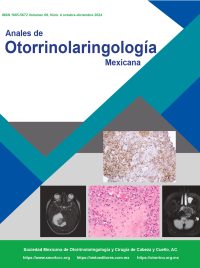
Detection of pilocytic astrocytoma in childhood through audiological symptoms and electrophysiological studies.
An Orl Mex. 2024; 69 (4): 265-271. https://doi.org/10.24245/aorl.v69i4.9959
María del Rosario Méndez Ramírez,1 Ariadna María Canales Vargas,1 Delia Itzel Arreola Méndez,3 Ana Luisa Lino González2
1 Subdirección de Audiología, Foniatría y Patología del Lenguaje.
2 Subdirección de Investigación Biomédica, Neurociencias Clínica.
Instituto Nacional de Rehabilitación Luis Guillermo Ibarra Ibarra, Ciudad de México.
3 Facultad de Medicina, Instituto Tecnológico de Monterrey, Ciudad de México.
Resumen
ANTECEDENTES: Los astrocitomas pilocíticos son tumores del sistema nervioso central que afectan con frecuencia a pacientes pediátricos (0 a14 años). Su crecimiento es lento y produce síntomas según su localización. Los datos clínicos implicados son ataxia, vómito, dolor de cabeza y pérdida auditiva moderada a profunda de tipo neurosensorial. La hipoacusia unilateral ocurre en un 46% y las alteraciones en potenciales evocados del tallo cerebral en 90 al 98% de los casos. En la resonancia magnética nuclear suele observarse una masa quística bien delimitada, con un nódulo sólido excéntrico y realzado. Existen escasos reportes en la bibliografía de astrocitoma pilocítico del ángulo pontocerebeloso.
CASO CLÍNICO: Paciente femenina de 12 años en quien la audiometría y los potenciales auditivos evocados de tallo cerebral confirmaron hipoacusia neurosensorial superficial izquierda y latencias alargadas que, junto con los síntomas manifestados por la paciente, condujeron a solicitar estudio de resonancia magnética que mostró una lesión de aspecto tumoral en el hemisferio cerebeloso izquierdo. Mediante análisis de biopsia se estableció el diagnóstico de astrocitoma pilocítico.
CONCLUSIONES: En todos los casos de hipoacusia en pacientes pediátricos es fundamental realizar interrogatorio directo cuando sea posible.
PALABRAS CLAVE: Astrocitoma pilocítico; hipoacusia neurosensorial; acúfeno; audiometría; pediatría.
Abstract
BACKGROUND: Pilocytic astrocytomas are tumors of the central nervous system that frequently occur in pediatric patients (0 to 14 years). Its growth is slow and produces symptoms depending on its location. The symptoms involved are ataxia, vomiting, headache and moderate to profound sensorineural hearing loss. Unilateral hearing loss occurs in 46% and alterations in brainstem evoked potentials in 90% to 98% of cases. Magnetic resonance imaging usually shows a well-defined cystic mass with an eccentric and enhancing solid nodule. There are few reports in the literature of pilocytic astrocytoma of the cerebellopontine angle.
CLINICAL CASE: A 12-year-old female patient, in whom audiometry and brain stem auditory evoked potentials confirmed left superficial sensorineural hearing loss and the presence of elongated latencies that, together with the symptoms expressed by the patient, led to requesting a magnetic resonance study that showed a tumor-like lesion in the cerebellar left hemisphere. Through biopsy analysis, a diagnosis of pilocytic astrocytoma was determined.
CONCLUSIONS: In all cases of hearing loss in pediatric patients, it is essential to conduct direct questioning when possible.
KEYWORDS: Pilocytic astrocytoma; Sensorineural hearing loss; Tinnitus; Audiometry; Pediatrics.
Recibido: 16 de julio 2024
Aceptado: 18 de octubre 2024
Este artículo debe citarse como: Méndez-Ramírez MR, Canales-Vargas AM, Arreola-Méndez DI, Lino-González AL. Detección de astrocitoma pilocítico en la infancia mediante síntomas audiológicos y estudios electrofisiológicos. An Orl Mex 2024; 69 (4): 265-271.

